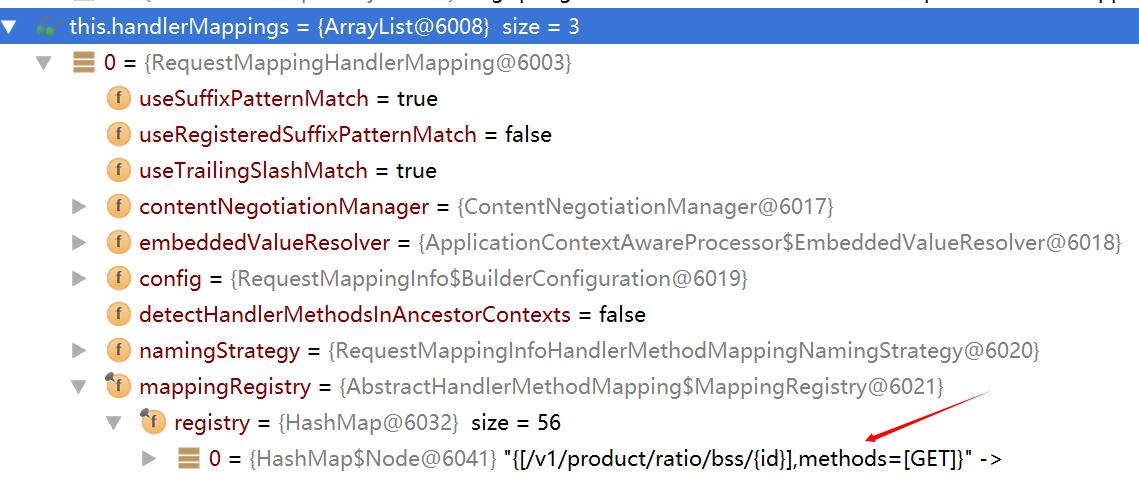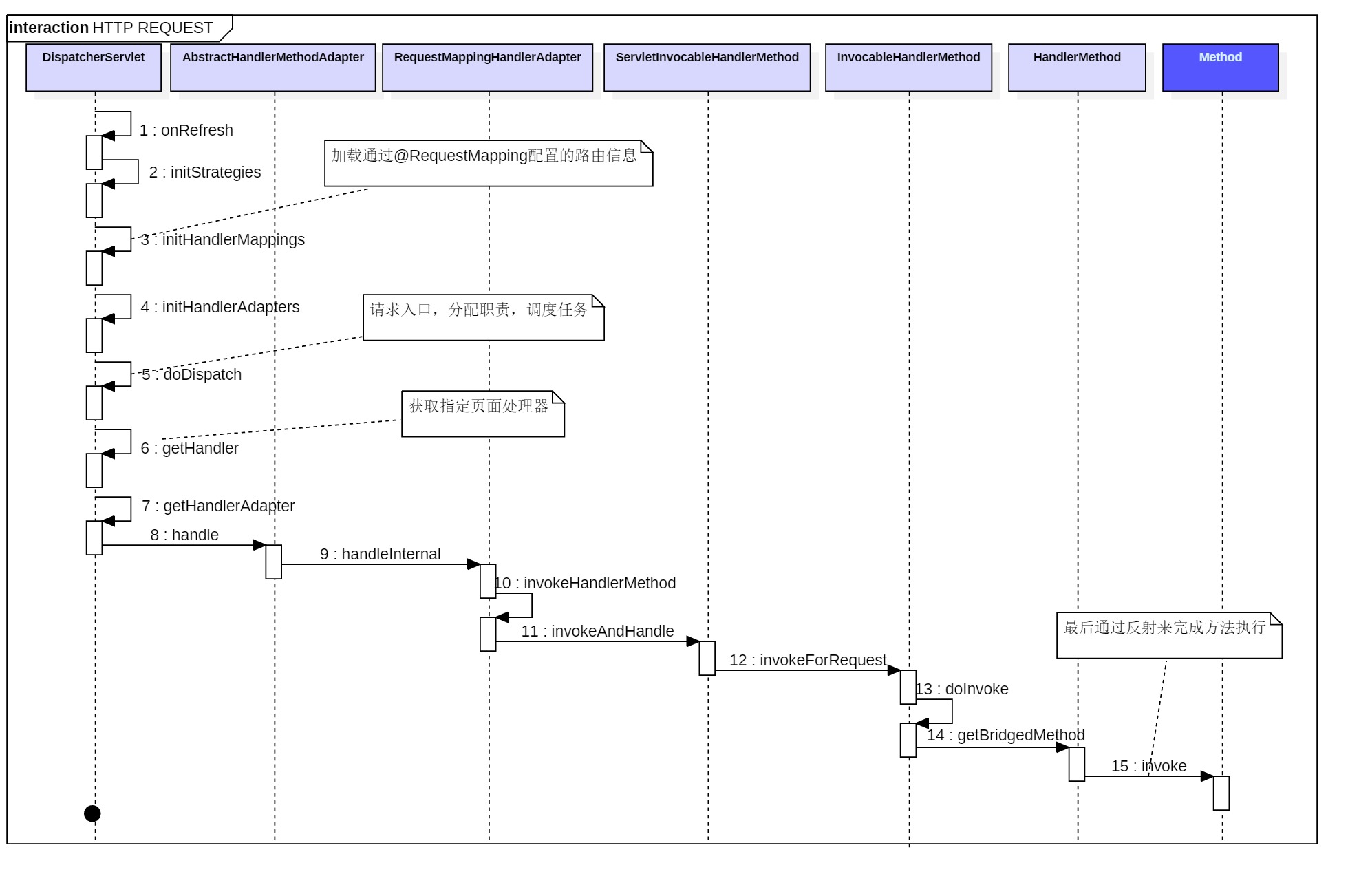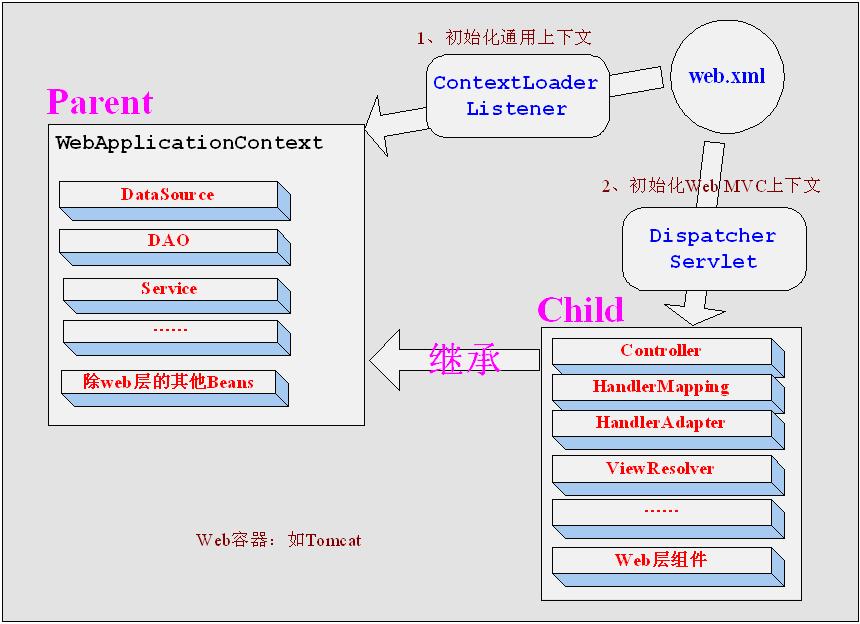Spring MVC中的HandlerMapping与HandlerAdapter
Spring MVC中的HandlerMapping与HandlerAdapter的关系
最近和同事讨论一个spring mvc的问题,问到HandlerMapping与HandlerAdapter有什么关系?虽然使用spring mvc时间也不短,但是瞬间能起来的只有两个关键词:
- @RequestMapping,这个经常用的,每个 Controller下面的action方法上一般都会定义一个特有的url路径。当HTTP请求请求发送到服务端后会根据url来查找应该执行哪个Controller下面的哪个action,我理解为url与java代码的一个路由关系。
@RequestMapping(value = "/bss/{priceId}", method = RequestMethod.GET)
public ValueResult<ProductPrice> getProductPrice(HttpServletRequest request,
@Min(value = 1,message = "priceId不合法")
@PathVariable final long priceId) {
//省略
}
- HandlerInterceptor,这个也是经常用的,做请求拦截时比较常用。
上面两个关键词尽管与问题有所关联,但很明显不是主要的,核心还是这两个接口都是做什么的,两者之间有什么互动。于是我们可以从一个请求开始调试下spring mvc的调用过程,以此来分析它们的作用以及关系。
Spring MVC配置
两个配置文件:
- 应用程序级别的applicationContext.xml,一般加载非web的配置,比如数据库配置,redis配置等等。
- web级别的mvc-dispatcher-servlet.xml,这里专注mvc的配置。
XmlWebApplicationContext context = new XmlWebApplicationContext();
context.setConfigLocations(new String[]{"classpath*:applicationContext.xml","classpath*:spring/mvc-dispatcher-servlet.xml"});
ServletContextHandler spingMvcHandler = new ServletContextHandler();
spingMvcHandler.setContextPath(appConfig.getContext());
spingMvcHandler.addEventListener(new ContextLoaderListener(context));
spingMvcHandler.addServlet(new ServletHolder(new DispatcherServlet(context)), "/*");
这里引用《张开涛》同学的图来说明上面两个配置的作用以及关系:
两个核心类
- ContextLoaderListener
这的作用主要是在启动web容器时加载ApplicationContext的信息,用来创建ROOT ApplicationContext的,可以接收XML类型的,比如XmlWebApplicationContext,它将从XML配置文件中加载配置信息。
这篇它不是重点至此主止。
- DispatcherServlet
也叫前端控制器,它是Spring MVC的统一访问入口,负责职责的分配以及工作调试,由于它的功能复杂这里只关心与HandlerMapping与HandlerAdaper的内容。下面是初始化的功能,其中有初始化HandlerMapping与HandlerAdaper。
@Override
protected void onRefresh(ApplicationContext context) {
initStrategies(context);
}
/**
* Initialize the strategy objects that this servlet uses.
* <p>May be overridden in subclasses in order to initialize further strategy objects.
*/
protected void initStrategies(ApplicationContext context) {
//其它初始化
initHandlerMappings(context);
initHandlerAdapters(context);
//其它初始化
}
initHandlerMappings,主要是调用BeanFactoryUtils.beansOfTypeIncludingAncestors,其中一种非常重要的HandlerMapping是RequestMappingHandlerMapping,我们通过在Controller方面上加@RequestMapping注释来配合使用,系统会将我们配置的RequestMapping信息注册到其中,详细数据参数此图:mappingRegistry中包含了所有的请求路由信息。

代码如下:
private void initHandlerMappings(ApplicationContext context) {
this.handlerMappings = null;
if (this.detectAllHandlerMappings) {
// Find all HandlerMappings in the ApplicationContext, including ancestor contexts.
Map<String, HandlerMapping> matchingBeans =
BeanFactoryUtils.beansOfTypeIncludingAncestors(context, HandlerMapping.class, true, false);
if (!matchingBeans.isEmpty()) {
this.handlerMappings = new ArrayList<HandlerMapping>(matchingBeans.values());
// We keep HandlerMappings in sorted order.
AnnotationAwareOrderComparator.sort(this.handlerMappings);
}
}
//不加载全部的先省略
//加载默认的逻辑先省略
}
DispatcherServlet核心方法:doDispatch,三个重要步骤:
- getHandler,获取页面处理器,通俗点就是获取由哪个Controller来执行,包含方法信息以及方法参数等信息。
- getHandlerAdapter,获取HandlerAdapter,它包含一个handle方法,负责调用真实的页面处理器进行请求处理并返回一个ModelAndView。HandlerAdpter里面有一些常见的处理,比如消息转移,参数处理等,详见此图:里面的argumentResolvers可以用来处理请求的参数,messageConverts是作消息转换等等。

- HandlerAdapter.handle,执行真实页面处理器的处理请求。
请求时序图(只关注HandlerMapping与HandlerAdapter)
doDispath获取页面处理器,然后根据页面处理器获取对应的HanlerAdapter,最后由HanlerAdaper来调用页面处理器的方法。
protected void doDispatch(HttpServletRequest request, HttpServletResponse response) throws Exception {
//初始化省略
try {
ModelAndView mv = null;
Exception dispatchException = null;
try {
processedRequest = checkMultipart(request);
multipartRequestParsed = (processedRequest != request);
// Determine handler for the current request.
mappedHandler = getHandler(processedRequest);
if (mappedHandler == null || mappedHandler.getHandler() == null) {
noHandlerFound(processedRequest, response);
return;
}
// Determine handler adapter for the current request.
HandlerAdapter ha = getHandlerAdapter(mappedHandler.getHandler());
//其它逻辑省略
// Actually invoke the handler.
mv = ha.handle(processedRequest, response, mappedHandler.getHandler());
//其它逻辑省略
}
catch (Exception ex) {
dispatchException = ex;
}
processDispatchResult(processedRequest, response, mappedHandler, mv, dispatchException);
}
//异常逻辑省略
}
具体的调用逻辑比较复杂,只选取与HandlerMapping与HandlerAdaper的部分,时序图图如下:

引用
http://jinnianshilongnian.iteye.com/blog/1602617



 浙公网安备 33010602011771号
浙公网安备 33010602011771号